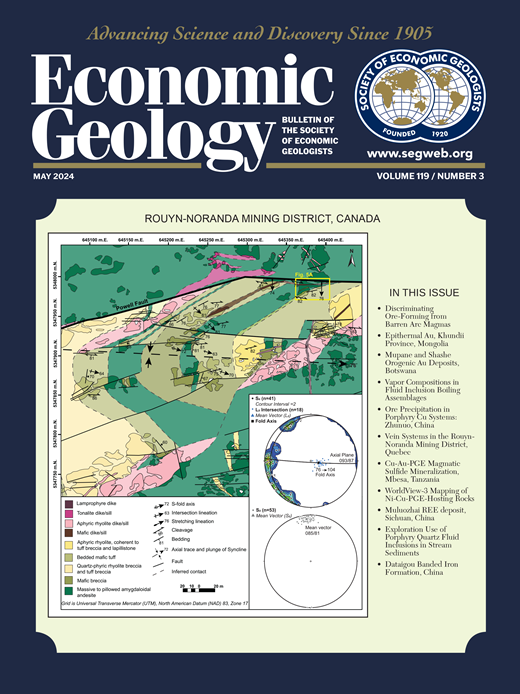High-Grade Copper and Gold Deposited During Postpotassic Chlorite-White Mica-Albite Stage in the Far Southeast Porphyry Deposit, Philippines
IF 5.5
1区 地球科学
Q1 GEOCHEMISTRY & GEOPHYSICS
引用次数: 1
Abstract
Ninety-eight underground diamond holes (~102 km) drilled by Far Southeast Gold Resources Inc. at the Far Southeast porphyry Cu-Au deposit, Philippines, from 2011 to mid-2013, provide a three-dimensional exposure of the deposit between 700- and –750-m elevation, with surface at ~1,400-m elevation. Far Southeast contains an inferred resource of 891.7 million tonnes (Mt) averaging 0.7 g/t Au and 0.5 wt % Cu, equivalent to 19.8 Moz Au and 4.5 Mt Cu. This contribution reports the spatial and temporal distribution of alteration and mineralization at Far Southeast, notably a white-mica–chlorite-albite assemblage that formed after early secondary biotite and before late quartz–white-mica–pyrite alteration and that is associated with the highest copper and gold grades. Alteration assemblages were determined by drill core logging, short-wavelength infrared (SWIR) spectral analysis, petrographic examination, and a quantitative evaluation of materials by scanning electron microscopy (QEMSCAN) study. Alteration is limited around sparse veins or pervasive where vein density is high and the alteration halos coalesce. The alteration and mineralization zones with increasing depth are as follows: (1) the lithocap of quartz-alunite–dominated advanced argillic-silicic alteration that hosts part of the Lepanto high-sulfidation Cu-Au epithermal deposit (mostly above ~700-m elevation), (2) an aluminosilicate-dominated zone with coexisting pyrophyllite-diaspore ± kandite ± alunite and white mica (~700- to ~100-m elevation), (3) porphyry-style assemblages characterized by stockwork veins (below ~500-m elevation), (4) the 1 wt % Cu equivalent ore shell (~400- to –300-m elevation), and (5) an underlying subeconomic zone (about –300- to –750-m elevation, the base of drilling). The ore shells have a typical bell shape centered on a dioritic intrusive complex. The paragenetic sequence of the porphyry deposit includes stage 1 granular gray to white quartz-rich (± anhydrite ± magnetite ± biotite) veins with biotite-magnetite alteration. These were cut by stage 2 lavender-colored euhedral quartz-rich (± anhydrite ± sulfides) veins, with halos of greenish white-mica–chlorite-albite alteration. The white mica is largely illite, with an average 2,203-nm Al-OH wavelength position. The albite may reflect the mafic nature of the diorite magmatism. The quartz veins of this stage are associated with the bulk of copper deposited as chalcopyrite and bornite, as well as gold. Thin Cu sulfide (chalcopyrite, minor bornite) veins with minor quartz and/or anhydrite (paint veins), with or without a white-mica halo, also occur. These veins were followed by stage 3 anhydrite-rich pyrite-quartz veins with white-mica (avg 2,197 nm, illite)–pyrite alteration halos. Combined with previous studies, we conclude that this porphyry system, including the Far Southeast porphyry and Lepanto high-sulfidation Cu-Au deposits, evolved over a period of 0.1–0.2 m.y. Three diorite porphyry stocks were emplaced, and by ~1.4 Ma biotite-magnetite–style alteration formed with quartz-anhydrite veins and deposition of ≤0.5% Cu and ≤0.5 g/t Au (stage 1); coupled with this alteration style, a barren lithocap of residual quartz with quartz-alunite halo plus kandite ± pyrophyllite and/or diaspore formed at shallower depth (>700-m elevation). Subsequently, lavender quartz and anhydrite veins with bornite and chalcopyrite (high-grade stage, avg ~1 wt % Cu and ~1 g/t Au) and white-mica–chlorite-albite halos formed below ~400-m elevation (stage 2). They were accompanied by local pyrite replacement, the formation of hydrothermal breccias and Cu sulfide (paint) veins. Stage 2 was followed at ~1.3 Ma by the formation of igneous breccias largely along the margins of the high-grade zones and stage 3 pyrite-quartz-anhydrite ± chalcopyrite veins with white-mica (mostly illitic) halos. At shallower depths in the transition to the base of the lithocap, cooling led to the formation of aluminosilicate minerals (mainly pyrophyllite ± diaspore ± dickite) with anhydrite plus high-sulfidation-state sulfides and pyrite veinlets. Consistent with previous studies, it is likely that the lithocap-hosted enargite-Au mineralization formed during this later period.菲律宾远东南斑岩矿床钾化后绿泥石-白云母-钠长石阶段高品位铜和金的沉积
2011年至2013年中期,Far Southeast Gold Resources Inc.在菲律宾Far Southeast斑岩铜金矿床钻探了98个地下钻石孔(约102公里),提供了该矿床海拔700至- 750米之间的三维暴露图,地表海拔约1400米。Far southeastern包含8.917亿吨的推断资源,平均为0.7 g/t Au和0.5 wt % Cu,相当于1980万盎司Au和450万公吨Cu。该贡献报告了远东南地区蚀变和矿化的时空分布,特别是在早期次生黑云母蚀变之后和晚期石英-白云母-黄铁矿蚀变之前形成的白云母-绿泥石-钠长岩组合,与最高的铜和金品位有关。通过岩心测井、短波红外(SWIR)光谱分析、岩石学检查和扫描电镜(QEMSCAN)材料定量评价研究,确定了蚀变组合。蚀变局限在稀疏脉脉周围,或在脉脉密度高且蚀变晕合并的地方普遍存在。随着深度的增加,蚀变带和矿化带主要有:(1)以石英-明矾石为主的高级泥硅蚀变岩盖,为勒班陀部分高硫化度铜-金浅成热液矿床(海拔高度在~700 ~ ~100 m以上);(2)以铝硅酸盐为主,叶黄岩-一水硬石±坎地岩±明矾石与白色云母共存的带(海拔高度在~700 ~ ~100 m);(3)以网状脉为特征的斑岩型组合(海拔高度在~500 ~ ~ 300 m以下);(5)一个潜在的次经济区(约- 300至- 750米海拔,钻井的基础)。矿壳呈典型的钟形,以闪长岩侵入杂岩为中心。斑岩矿床共生序列为1期粒状灰白色富石英(±硬石膏±磁铁矿±黑云母)脉,并伴有黑云母-磁铁矿蚀变。这些是由第2阶段淡紫色的自面体石英(±硬石膏±硫化物)矿脉切割而成,带有绿白色云母-绿泥石-钠长岩蚀变晕。白色云母主要为伊利石,Al-OH平均波长为2203nm。钠长岩可能反映闪长岩岩浆活动的基性。这一阶段的石英脉与大部分铜(黄铜矿和斑铜矿)以及金有关。薄的硫化铜(黄铜矿,少量斑铜矿)脉与少量石英和/或硬石膏(油漆脉),有或没有白云母晕也会出现。第三阶段为富硬石膏黄铁矿-石英脉,含白云母(平均2197 nm,伊利石)-黄铁矿蚀变晕。结合前人研究,认为该斑岩体系演化时间为0.1 ~ 0.2 m.y,包括远东南斑岩和勒班陀高硫化度铜金矿床,3个闪长斑岩群侵位,经~1.4 Ma黑云母-磁铁矿型蚀变形成,石英-硬硬岩脉沉积≤0.5% Cu和≤0.5 g/t Au(第1阶段);与这种蚀变样式相结合,在较浅深度(海拔>700 m)形成了带有石英-明矾石晕的残余石英和坎岩±叶蜡岩和/或一水硬石的贫瘠岩盖。随后,在海拔~400 m以下形成了含斑铜矿和黄铜矿的薰衣草石英和硬石膏脉(高品位阶段,平均Cu ~1 wt %, Au ~1 g/t)和白云母-绿泥石-钠长石晕(第二阶段),并伴有局部黄铁矿替代、热液角砾岩和硫化物(漆)脉的形成。第2阶段在~1.3 Ma形成火成岩角砾岩,主要沿高品位带边缘形成;第3阶段黄铁矿-石英-硬石膏±黄铜矿脉,带白色云母(主要为伊利石)晕。在向岩盖底部过渡的较浅深度,冷却导致铝硅酸盐矿物(主要是叶蜡石±一水硬石±二水硬石)与硬石膏加高硫化态硫化物和黄铁矿细脉的形成。与前人的研究一致,这一时期很可能形成了以岩盖为主的辉铝金矿化。
本文章由计算机程序翻译,如有差异,请以英文原文为准。
求助全文
约1分钟内获得全文
求助全文
来源期刊

Economic Geology
地学-地球化学与地球物理
CiteScore
10.00
自引率
6.90%
发文量
120
审稿时长
6 months
期刊介绍:
The journal, now published semi-quarterly, was first published in 1905 by the Economic Geology Publishing Company (PUBCO), a not-for-profit company established for the purpose of publishing a periodical devoted to economic geology. On the founding of SEG in 1920, a cooperative arrangement between PUBCO and SEG made the journal the official organ of the Society, and PUBCO agreed to carry the Society''s name on the front cover under the heading "Bulletin of the Society of Economic Geologists". PUBCO and SEG continued to operate as cooperating but separate entities until 2001, when the Board of Directors of PUBCO and the Council of SEG, by unanimous consent, approved a formal agreement of merger. The former activities of the PUBCO Board of Directors are now carried out by a Publications Board, a new self-governing unit within SEG.
 求助内容:
求助内容: 应助结果提醒方式:
应助结果提醒方式:


